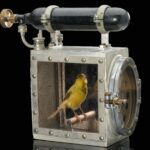
Birds and wildfire smoke
We can take many steps to improve indoor air quality for our birds. Choosing less toxic cleaning methods and safer paints are two that I’ve already written about. However, if you live in an area prone to wildfires, the smoke from these fires can become extremely hazardous and impact human health.
In this article, I’ll list some things you can do, starting with free or low-cost, and gradually getting more expensive and involved.
#1: Research your local outdoor air quality (free)
There are many free websites and apps where you can check the air quality in your area. Three main ones have a global presence:
IQAir has one of the nicest sites out there. They provide a lot of help in understanding air quality data and try not to bombard you with too much information. They also provide graphs of recent air quality and a forecast. There is an excellent companion mobile app called AirVisual.
World Air Quality Index is a compact, attractive site that also offers deep historical data. They don’t have an app, but you can save a link to their Air Quality Index Widget for viewing on a mobile phone.
PurpleAir offers a firehose of air quality data from a massive network of air quality stations, including one in my backyard. The website is clunky and also difficult to use on a mobile phone. However, a 3rd party application called Paku (iOS and macOS) is a pretty nice interface for PurpleAir data. Presumably, there are Windows and Android options, but I have not explored them.
Finally, weather apps and websites may also incorporate air quality information. If you do a Google search for “air quality near me“, you will likely find some country-specific resources as well as see the current AQI at your location.
The historical air quality data available from some of these sources may help guide your efforts to prepare for future smoke events.
There’s no good data on what a good target for indoor air quality would be for birds. For humans, an AQI of 150 is the threshold where health effects will start to surface. For sensitive people (and possibly for birds), an AQI of 100 is a reasonable upper limit.
#2: Get notified when your air quality gets bad (free)
Air quality can sometimes change quickly and can be bad even though you don’t see or smell smoke. Your best bet is to set up notifications to inform you when air quality gets bad. I’ve had luck setting these up in the AirVisual app or in CARROT Weather. In both cases, you can set up a notification for air exceeding a threshold or dropping below a threshold.
Also, many weather apps and websites can notify you of severe weather alerts, including alerts about bad air quality. Your local government may also offer a notification service. Try a Google search for “weather alerts near me” as a starting point.
#3: Basic measures (free or very inexpensive)
Now that you know how to check your current air quality or get notified when it’s bad, you can get your windows and doors closed. If you also set up notifications for when the air has improved, you can open your windows again to bring in some fresh, cleaner air. If your windows lock, engaging them could improve the seal to keep the house airtight. A visit to the local hardware store might provide DIY options for improving door and window seals.
#4: Use the air filter you may already have (inexpensive)
Forced air heating and cooling systems all have filters. Typically, they are ultra cheap, and no one ever, ever changes them. They can be incredibly effective at filtering your indoor air. Most systems let you turn on just the fan without injecting heating or cooling. To be effective, you’ll need to run your fan regularly.
First option: If you’ve either never changed it or it’s been more than a year, change it right now. Pet dander, pollen, and dust love to get stuck into these filters.
Second option: Consider buying a better filter. The difference between a crummy filter and a good one might be as little as $10 to $20. Change your filter more often if you have a bad fire season.
A furnace filter can clean the air for an entire house, making it very cost-effective. Air cleaners are needed for each room where you want to improve the air. If you live in an area with significant smoke problems and don’t mind the expense, you can get a top-of-the-line filter for more than $100.
Here are some price comparisons for 3M furnace filters for reference. I used a 20x25x1 filter, which is a common size. Note that this is considered a trustworthy brand, so it is likely more expensive than an off-brand filter.
- Commonly used filter, but not good for smoke: Filtrete MPR 1000 (MERV 11) = $11 each (if you buy a pack of 4)
- Minimum for smoke: Filtrete MPR 2200 (MERV 13) = $21 each (if you buy a pack of 6)
A couple of things you’ll notice:
- Furnace filters are actually quite cheap!
- The cost difference between a substandard filter and one that will filter smoke is small.
- Buying a multi-pack or signing up for a filter subscription can save you a lot of money.
If you have a furnace with a large filter box—five inches is a common size—you can buy even more hard-core filters. For example, the Lennox X6675 (MERV 16) is $98 each (if you buy a pack of 2). Considering the projected lifetime of a year, it might be worth the cost, depending on how much bad air seeps into your house and whether a less expensive filter is up to the task.
#5: Invest in an air quality monitor (inexpensive to moderately expensive)
Before you spend significant money on air cleaners, consider investing in an air quality monitor. This will tell you whether you have a problem and whether your efforts to improve the air are actually working. If you have a newer house, you may find that just shutting windows is enough to keep the air quality acceptable. You may find out that your furnace filter is working fine or maybe you need to run the fan more often.
An air quality monitor can range from about $50 for an indoor monitor to $250 if you want one that also reports outdoor air quality from remote stations. Be sure to get one that reports the Air Quality Index (AQI). That means you will monitor smoke, smog, and other pollutants from things like paint or cleaners in your home.
Here’s an inexpensive indoor option (which I’ve not used) and a more expensive indoor/outdoor model (which I’m currently using).
An effective way to reduce costs is to get a group of people together to buy one shared air quality monitor. A good monitor will show the air quality in a matter of seconds.
#6: Invest in an air cleaner (expensive to very expensive)
You can find inexpensive air cleaners, but if you want to remove smoke effectively, you’re looking at roughly $200-$300 for something that will cover a room and up to $1,000 for something that will cover a large living area or a small home. While a furnace filter can sometimes be enough, it’s possible that it won’t be able to keep up. An air cleaner will move significantly more air and push it through the filter.
It’s worth consulting something like Consumer Reports (subscription required) for advice. Unfortunately, many products claim they are excellent for smoke but don’t hold up well when tested. Most air cleaners can filter some amount of smoke, but it may not be sufficient during a heavy smoke event.
One of the only brands that score consistently well for smoke is Blueair. Some brands can have terrible products at the low end, but excellent ones at a higher cost, so you can’t go on brand alone. My best advice is to check the return policy beforehand and save the packaging.. Try out the air cleaner using your air quality monitor and if it doesn’t work, return it.
#7: Do-it-yourself air cleaner (inexpensive, but tricky)
Some people will construct their own do-it-yourself air cleaners using good-quality furnace filters paired with a box fan. Although you can save a lot of money, there are tradeoffs:
- You must seal the system very well, or it will be ineffective.
- Even done right, it’s likely not going to clean your air as well as an air cleaner. It may be suitable for emergency situations, however.
Check out this site or do a Google search for “box fan air cleaner“, and you can get some ideas. You won’t win any beauty contests, but you could save some money. If you follow my advice for getting an air quality monitor, you’ll know whether your DIY air purifier is working. It’s money down the drain if it doesn’t work, whereas the better-known air purifiers have been tested for their ability to filter air properly.
#8: Backup power (extremely expensive to insanely expensive)
Using an air quality monitor, you can determine how effective furnace filters and air cleaners are for your home. To experiment during a smoke episode, turn off your furnace fan and air cleaners and watch the indoor air quality closely. If you see it worsen significantly in an hour, think about what that means if you were to lose power.
If you live in an area with dodgy power or a history of outages or rolling blackouts during the fire season, you may want to consider backup options.
One option is a gas or electric generator. You’re looking at something in the neighbourhood of several hundred dollars to several thousand dollars. This depends on whether you want to get enough power just to run some air cleaners or whether you want to power more of your house. I have two of these small electric battery stations that can be used to run a room air cleaner for anywhere from 5 to 33 hours, depending on the fan speed.
Another option is a battery backup system for your home. This could run anywhere from a few thousand dollars to ten thousand dollars for a single battery. The battery sizes are typically 6 to 20 times the size of the portable battery station pictured above.
Conclusion
Well, you can definitely spend a lot of money on air quality! But there are many things you can do for free or for a small amount of money. With an air quality monitor, you can carefully spend more if you find it will make a difference.
Most people don’t pay any attention to their indoor air quality. Poor indoor air can harm your health, make you develop allergies, or make you feel sick. It’s worth looking into and at least doing some of the free or low-cost options.
Maybe your birds can inspire you if you’ve never looked into air quality before.










